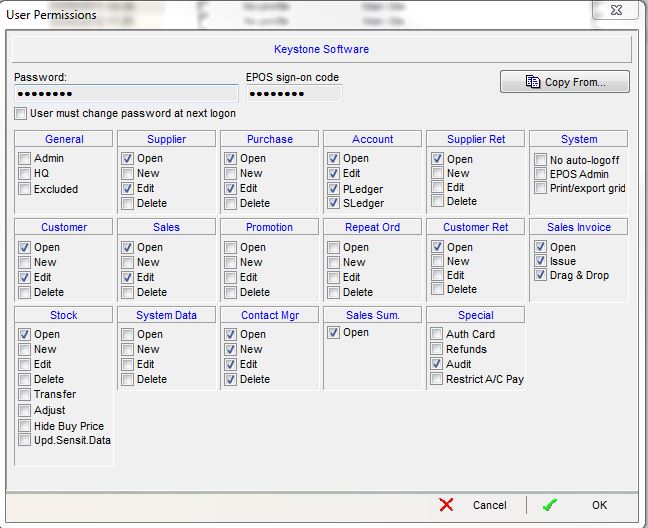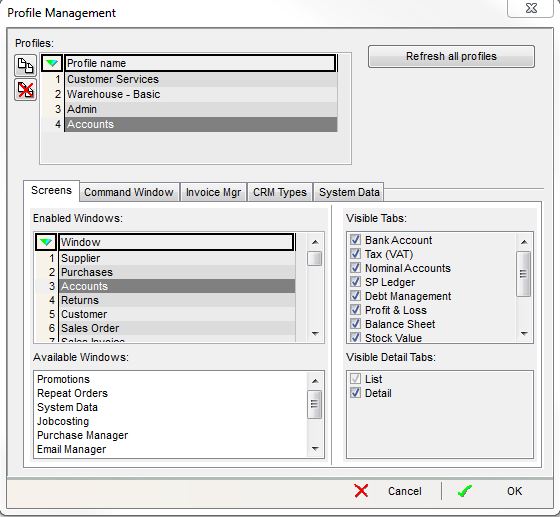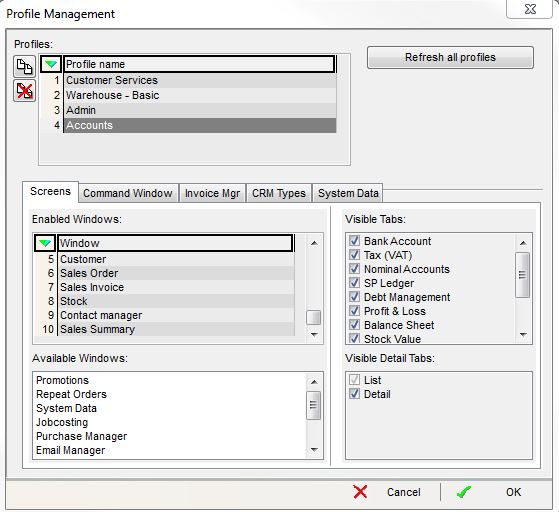How To: Create a New Accounting User
Overview
When creating a new user with a specific role, it is necessary to define both permissions (what they can do) and a profile (what they can see). Here is an exemplar of how a new Accounting User might be created and set up. As a rule, it is best to start by setting permissions and access to the minimum levels possible for the role in question. Extra permissions and access can then be enabled if and when required. The permissions necessary for an Accounting User may at first glance seem self evident, but, as in our example, permission may need to be granted to view and edit Customers and Suppliers in order to adjust credit terms, etc.
Creating New User
- Open a System Data screen.
- Double click on
[ Others | Users ]. - Press Alt+E or click
 to enter edit mode.
to enter edit mode. - Press F3 or click
 to add a new item.
to add a new item. - Enter the details of the new user (see Users for a description of the grid columns).
- Press Ctrl+S or click
 to save the new user.
to save the new user.
Setting User Permissions
- Select User Permissions from the right-click context menu and set these as required.
Below is a screenshot of typical settings that might be used for a Accounting User - these may need to be adjusted to suit specific business requirements, for example:
- Depending on the seniority of the Accounts User, permission to operate at Admin or HQ Level may be granted
- It may be decided to disable the ability to edit Purchases

In this example, the Accounting User has been given full access to the accounting and sales invoice functions. These permissions might normally be denied to users with non-accounting duties.
Creating User Profiles
- Right click on the grid and select 'Define Profiles'.
- Select 'Yes' to the information dialog displayed.
- Click on
 to add a blank profile to the bottom of the Profiles grid.
to add a blank profile to the bottom of the Profiles grid. - In the Profile Management dialog add a name for the profile and select it.
- In the Screens' tab, drag and drop screens required for the profile from the Available Windows grid into the Enabled Windows grid.
- Untick the Visible Tabs and Visible Detail Tabs that are not required for the profile for every enabled screen.
- In the Command Window tab, check the Command Window options that are required for the profile.
- In the Invoice Mgr tab, check the stages that are required for the profile.
- In the CRM Types Tab check all the CRM Types that will be blocked for this profile.
- Click on 'OK'.
Below are screenshots of typical settings that might be used for a Accounting User - these may need to be adjusted to suit specific business requirements
Note we have shown 2 screenshots to show the full range of enabled screens, as the window is to small to show them all without scrolling


